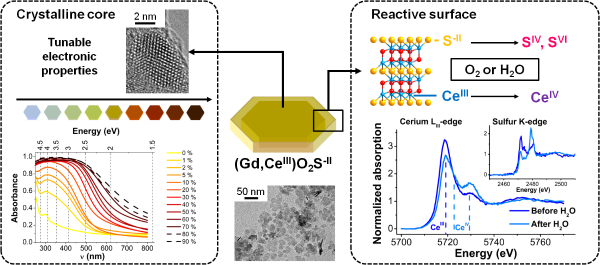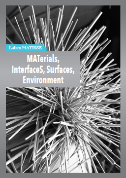Aller au contenu Aller au menu Aller à la recherche
 Navigation de la rubrique abonnements, dernières nouvellesPartenaires
Navigation de la rubrique abonnements, dernières nouvellesPartenaires
 accès rapides, services personnalisésTraductions :Labex MATISSE
accès rapides, services personnalisésTraductions :Labex MATISSE
MATériaux, InterfaceS, Surfaces, EnvironnementFil d'arianeAccueil / RECHERCHE / PROJETS DE RECHERCHE / Projets de l'Axe 2 - Matériaux multifonctionnels et environnement / Thèses axe 2 / Oxysulfures nanométriques : nouvelles approches synthétiques pour le contrôle des propriétés magnétiques et du band-gapRECHERCHEOxysulfures nanométriques : nouvelles approches synthétiques pour le contrôle des propriétés magnétiques et du band-gap

Axe 2 - Matériaux multifonctionnels et environnement
Thèse de Clément Larquet
Travail de recherche commencé le 1er octobre 2015.
Soutenance le mardi 25 septembre 2018 à 14h
Collège de France (Salle 2)
11 Place Marcelin Berthelot
75231 Paris
Laboratoires co-porteurs
Abstract
The first part of this thesis is dedicated to lanthanide oxysulfides Ln2O2S. In the bibliographic introduction, the history and properties of the bulk compounds are presented. The reaction conditions of the syntheses of Ln2O2S nanoparticles are then detailed. Gd2O2S nanoparticles are obtained via a synthesis in organic medium using Gd(acac)3, S8 and Na(oleate). Unsupported Ce2O2S nanoparticles are obtained for the first time by keeping the nanoparticles under inert atmosphere from the synthesis to the storage. The solid solution between Gd and Ce enables the formation of (Gd,Ce)2O2S nanoparticles. Their surface and their optical and magnetic properties are studied. For the first time, a formation mechanism with nucleation and growth steps is proposed. The alkaline source which is crucial for the crystallization is still debated; the mechanistic study unveiled a new role of formation of oleate aliphatic bilayers. A second part deals with the transition metal oxysulfides. After a quick introduction on the bulk phases, the scarce nanoscaled compounds are presented. The synthesis of Ln2O2S nanoparticles used in the first part is transposed to p- and d- block transition metals. Because of the differences in the coordination modes of the metals, the transposition is challenging but promising results were obtained with several metals. A last chapter is dedicated to the synthesis of nickel sulfides and oxysulfides at ambient temperature using a reactive complex of nickel and S8.

Publications
- Clément Larquet, Anh-Minh Nguyen, Estelle Glais, Lorenzo Paulatto, Capucine Sassoye et al.
Bandgap Engineering from Cation Balance: the Case of Lanthanide Oxysulfide Nanoparticles
Chemistry of Materials, American Chemical Society, In press,
DOI : 10.1021/acs.chemmater.9b00450⟩
HAL Id : hal-02167240v1 - Clément Larquet, Djamila Hourlier, Anh-Minh Nguyen, Almudena Torres-Pardo, Andrea Gauzzi et al.
Thermal Stability of Oleate‐Stabilized Gd2O2S Nanoplates in Inert and Oxidizing Atmospheres
ChemNanoMat, Wiley, In press,
DOI :10.1002/cnma.201800578
HAL Id : hal-02017819v1 - Clément Larquet, Yannick Klein, David Hrabovsky, Andrea Gauzzi, Clément Sanchez et al.
Tunable Magnetic Properties of (Gd,Ce) 2 O 2 S Oxysulfide Nanoparticles
European Journal of Inorganic Chemistry, Wiley-VCH Verlag, 2019, 2019 (6), pp.762-765
HAL Id : hal-02017810v1 - Clément Larquet, Anh-Minh Nguyen, Mario Ávila-Gutiérrez, Lionel Tinat, Benedikt Lassalle-Kaiser et al.
Synthesis of Ce 2 O 2 S and Gd 2(1– y ) Ce 2 y O 2 S Nanoparticles and Reactivity from in Situ X-ray Absorption Spectroscopy and X-ray Photoelectron Spectroscopy
Inorganic Chemistry, American Chemical Society, 2017,
DOI : 10.1021/acs.inorgchem.7b02336
HAL Id : hal-01635618v1
Autres types de publications
Distinctions
- European Young Chemist Award 2018 (silver medal) at 7th EuCheMS2018 (European Chemical Sciences) for the quality of his research as a young scientist in the field of chemical sciences.
Interventions orales
- 12/09/2016 : European Association for Chemical and Molecular Sciences Congress (EuCheMS), SEVILLE
Colloidal synthesis of oxysulfide nanoparticles (MxSyOz) toward new materials with tunable optical properties
C. Larquet, B. Lassalle, Y. Klein, D. Portehault, L. Paulatto, A. Gauzzi, C. Sanchez, S. Carenco - 27/09/2018 : European Association for Chemical and Molecular Sciences Congress (EuCheMS), LIVERPOOL
Cerium and sulfur oxidation mechanisms in (Gd,Ce)2O2S nanoparticles through XANES and NAP-XPS
C. Larquet, A.-M. Nguyen, L. Tinat, B. Lassalle, J.-J. Gallet, F. Bournel, A. Gauzzi, C. Sanchez, S. Carenco - 28/09/2018 : European Association for Chemical and Molecular Sciences Congress (EuCheMS), LIVERPOOL
Metal oxysulfide nanoparticles: unraveling their synthesis and properties towards optical, magnetic and catalytic applications
C. Larquet, A. Gauzzi, C. Sanchez, S. Carenco - 29/09/2018 : European Association for Chemical and Molecular Sciences Congress (EuCheMS), LIVERPOOL
Tuning the optical and magnetic properties of (Gd,Ce)2O2S oxysulfide nanoparticles through the Ce:Gd ratio
C. Larquet, A.-M. Nguyen, C. Maheu, C. Géantet, D. Hrabovsky, Y. Li, Y. Klein, L. Paulatto, A. Gauzzi, C. Sanchez, S. Carenco"
Présentations posters
- 13/06/2016 : Journée des doctorants IMPMC, PARIS
New Phases of Metal Oxysulfide (MxOySz) Nanomaterials with Tunable Band-Gap
C. Larquet, B. Lassalle, D. Portehault, L. Paulatto, A. Gauzzi, C. Sanchez, S. Carenco - 19/06/2016 : Ecole d'été C'Nano IDF, ETIOLLES
Colloïdal synthesis of oxysulfide nanoparticles (MxSyOz) with tunable magnetic and optical properties.
C. Larquet, B. Lassalle, D. Portehault, L. Paulatto, A. Gauzzi, C. Sanchez, S. Carenco - 20/06/2016 : Journée du Labex Matisse, PARIS
New Phases of Metal Oxysulfide (MxOySz) Nanomaterials with Tunable Band-Gap
C. Larquet, B. Lassalle, D. Portehault, L. Paulatto, A. Gauzzi, C. Sanchez, S. Carenc
10/10/19
Traductions :Egalement dans la rubrique

» En savoir plus sur «la plaquette de présentation du LabEx MATISSE (version anglaise)»
MATISSE en chiffres
- 4 disciplines : Chimie, Physique, Sciences de la Terre, Patrimoine
Contact
Direction
Florence Babonneau
Administration
matisse @ upmc.fr (matisse @ upmc.fr)
Communication
Emmanuel Sautjeau
emmanuel.sautjeau @ sorbonne-universite.fr (emmanuel.sautjeau @ sorbonne-universite.fr)
UPMC
4 place Jussieu 75005 Paris, France
Tél. +33 1 44 27 44 27Mentions légales | Accessibilité Navigation de la rubrique abonnements, dernières nouvellesPartenaires
Navigation de la rubrique abonnements, dernières nouvellesPartenaires
 accès rapides, services personnalisésTraductions :Labex MATISSE
accès rapides, services personnalisésTraductions :Labex MATISSE
